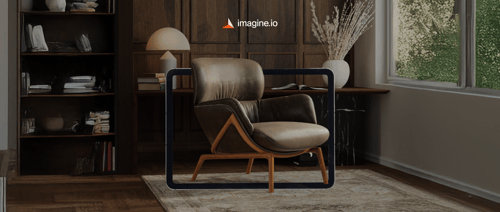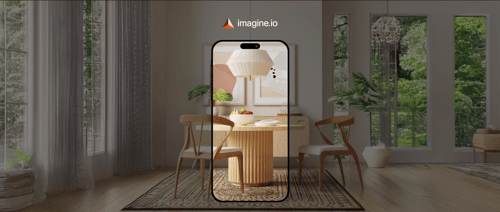Quick Listen:
Picture this: you're shopping online for a new armchair, staring at a static, uninspiring photo. Will it fit in your space? Does the color match your decor? A decade ago, you'd roll the dice and hope for the best. Now, a seismic shift is transforming e-commerce, powered by 3D product visualization and augmented reality (AR). These technologies are not mere gimmicks they're redefining how brands connect with consumers, turning browsing into an immersive experience. With the global visual content market set to soar from $9.04 billion in 2025 to $19.10 billion by 2033 at a 9.8% CAGR, e-commerce is no longer about flat images. It's about engagement, confidence, and trust.
The Transformation of Online Retail
E-commerce has come a long way from the days of pixelated thumbnails and sketchy product descriptions. Early online shoppers faced a leap of faith with every purchase, often disappointed by items that didn't match their expectations. Today's consumers demand more interactivity, clarity, and a sense of control. Technologies like 3D visualization and AR deliver just that, letting shoppers rotate a virtual watch or place a rug in their living room with a tap. This evolution mirrors an in-store experience, minus the crowds and long lines.
Platforms like imagine.io are at the forefront, democratizing access to 3D and AR tools for retailers big and small. The result is a digital marketplace where exploration trumps passive scrolling. This isn't a fleeting trend but part of a broader surge in digital content creation, a market valued at $32.28 billion in 2024 and projected to hit $69.80 billion by 2033 with a 13.9% CAGR. The message is clear: immersive content is no longer optional it's essential.
The Technologies Powering the Shift
At the heart of this revolution lies 3D product visualization. Unlike static photos, 3D models allow customers to inspect products from every angle think spinning a pair of headphones to check their design or zooming in on a sofa's stitching. This interactivity slashes the uncertainty that fuels cart abandonment. The visual search market, encompassing these tools, was worth $35.51 billion in 2023 and is expected to reach $150.43 billion by 2032, growing at a 17.4% CAGR, underscoring its transformative potential.
Augmented reality takes this a step further. AR enables shoppers to project virtual products into their real-world spaces. Picture pointing your phone at your kitchen and seeing a new dining table appear, perfectly scaled. This technology, part of a visual content market projected to grow from $6.01 billion in 2025 to $19.17 billion by 2033 at a 15.6% CAGR, is driving engagement by making “try before you buy” a reality. It's not just convenient it's a game-changer for decision-making.
Artificial intelligence (AI) completes the trifecta. By analyzing user preferences, AI delivers tailored visuals, like suggesting furniture that complements your existing setup or curating virtual try-ons based on your style. This personalization, fueled by a digital content creation market expected to reach $49.3 billion by 2033 at a 10.69% CAGR, transforms shopping into a curated, conversational experience. Together, these technologies are reshaping e-commerce into a dynamic, consumer-centric ecosystem.
Success Stories in Action
The impact of 3D and AR is vivid in real-world applications. Furniture giants like IKEA and Wayfair have embraced AR to create virtual showrooms. IKEA's app, for example, lets you place a Poäng chair in your living room, adjusting for scale and lighting. This clarity reduces the guesswork that makes furniture shopping daunting online, leading to happier customers and fewer costly returns. Furniture's high return rates often due to mismatched expectations are a perfect use case for AR's precision.
Fashion retailers are also reaping rewards. Brands like ASOS and Gucci leverage AR for virtual try-ons, allowing shoppers to “wear” a jacket or pair of glasses via their phone. This isn't just engaging it's practical, boosting conversion rates and tackling apparel's notorious return problem, which contributes to e-commerce's significant return challenges. By offering a clearer sense of fit and aesthetic, AR helps shoppers buy with confidence.
Consumer electronics brands like Apple and Samsung are also capitalizing on 3D visualization. Shoppers can explore a smartphone's ports or a TV's sleek curves by rotating a virtual model. These interactive experiences build trust, encouraging purchases by eliminating surprises. Across industries, 3D and AR are proving their worth, not just as flashy add-ons but as critical tools for customer satisfaction and loyalty.
Challenges on the Horizon
Despite their potential, 3D and AR face significant hurdles. Creating photorealistic 3D models demands expertise and computing power. A low-quality render say, a lamp that looks like it's from a dated video game can do more harm than good. Smaller retailers, in particular, struggle with the technical demands of fast-loading, high-fidelity visuals. The upfront costs of building or licensing these tools can also be prohibitive, posing a barrier for budget-conscious businesses.
Consumer adoption remains a challenge. While tech-savvy younger shoppers embrace AR, others may find it confusing or unnecessary. Retailers must invest in intuitive interfaces and education to bridge this gap. Privacy is another concern. AR apps often collect data on user's environments or preferences, raising red flags in an era where user-generated content and data security are under scrutiny. Businesses must prioritize transparency to maintain consumer trust.
The Business Case for Adoption
The obstacles are real, but the benefits are compelling. Immersive visuals keep shoppers engaged longer, increasing the likelihood of a purchase. Research indicates 3D and AR experiences can boost conversion rates significantly, a critical edge in e-commerce's cutthroat landscape. They also curb returns, particularly in high-risk categories like fashion and furniture, where rates can be substantial. When shoppers know exactly what they're getting, they're less likely to send it back.
Beyond sales, 3D and AR offer a branding advantage. Retailers who adopt these technologies position themselves as innovators, standing out in a saturated market. This differentiation fosters loyalty, as customers gravitate toward brands that make shopping intuitive and enjoyable. The investment in immersive tools isn't just about immediate ROI it's about building a future-proof brand.
Looking Ahead
The trajectory of e-commerce is unmistakably visual. Experts predict 3D and AR will become as fundamental as mobile-friendly websites are today. Innovations like haptic feedback imagine “feeling” a fabric through your device could elevate immersion further. AI will continue to refine personalization, ensuring every interaction feels tailored. The visual commerce platform market is poised for explosive growth, signaling a new era of innovation.
For retailers, the choice is stark: evolve or risk obsolescence. Platforms like imagine.io are making 3D and AR more accessible, leveling the playing field for businesses of all sizes. As online shopping dominates, success hinges on creating experiences that resonate. The brands that thrive will be those that empower customers to not just shop, but to connect, explore, and envision.
Next time you're browsing online, skip the flat photos. Rotate that vase. Place that desk. Try on those boots. E-commerce isn't just visual it's a revolution, and it's happening now.
Disclaimer: The above helpful resources content contains personal opinions and experiences. The information provided is for general knowledge and does not constitute professional advice.
You may also be interested in: imagine.io | Award Winning 3D + AI Product Visualization
Struggling with expensive, outdated product visuals that slow down your creative process and stunt eCommerce growth? imagine.io's AI-powered platform empowers furniture, home décor, and textile brands to effortlessly produce striking 3D images, immersive videos, AR experiences, and interactive configurators. Cut production costs up to 70%, boost conversions 5X, speed up prototyping, and supercharge your online sales. Ready to elevate your product visuals and captivate customers? Book a demo with imagine.io today!
Powered by flareAI.co




.png?width=500&name=How%20to%20Add%20a%203D%20Product%20Configurator%20to%20Your%20WordPress%20Website%20(Complete%20B2B%20Guide).png)
















%20(1).png?width=500&name=Why%20Exploded%20Mattress%20Views%20Matter%20(And%20How%20to%20Generate%20Them)%20(1).png)
.png?width=500&name=Best%20Shopify%20Product%20Configurator_%20How%20to%20Choose%20the%20Right%20One%20(2).png)
.png?width=500&name=Why%20Exploded%20Mattress%20Views%20Matter%20(And%20How%20to%20Generate%20Them).png)



.png?width=500&name=Best%20Shopify%20Product%20Configurator_%20How%20to%20Choose%20the%20Right%20One%20(1).png)







.png?width=500&name=How%203D%20Rendering%20Can%20Make%20or%20Break%20Your%20Industrial%20Design%20Pitch%20(1).png)








%20with%20Digital%20Twins%20and%203D%20Visualization.png?width=500&name=Optimizing%20Your%20Digital%20Asset%20Management%20(DAM)%20with%20Digital%20Twins%20and%203D%20Visualization.png)




.png?width=500&name=Styling%20Home%20Decor%20for%202025_%20From%20Global%20Influences%20to%20Playful%20Personalization%20(1).png)
